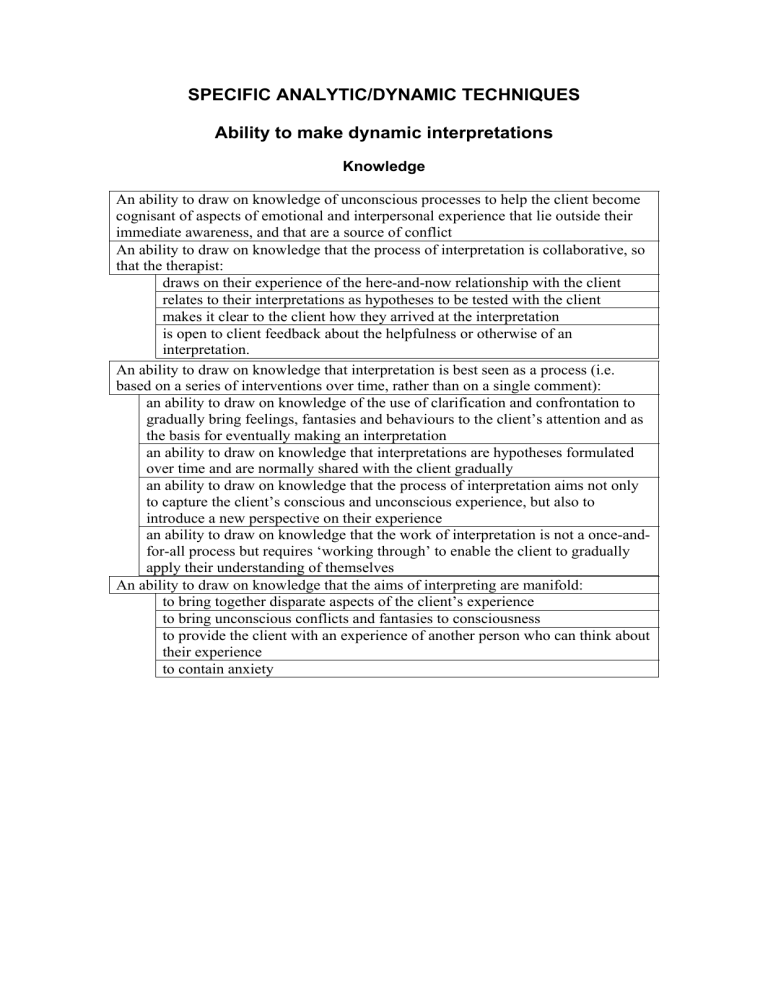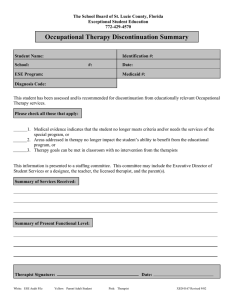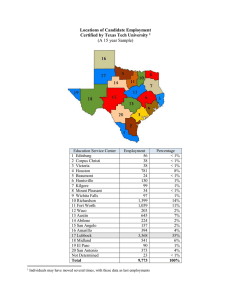SPECIFIC ANALYTIC/DYNAMIC TECHNIQUES Ability to make dynamic interpretations

SPECIFIC ANALYTIC/DYNAMIC TECHNIQUES
Ability to make dynamic interpretations
Knowledge
An ability to draw on knowledge of unconscious processes to help the client become cognisant of aspects of emotional and interpersonal experience that lie outside their immediate awareness, and that are a source of conflict
An ability to draw on knowledge that the process of interpretation is collaborative, so that the therapist: draws on their experience of the here-and-now relationship with the client relates to their interpretations as hypotheses to be tested with the client makes it clear to the client how they arrived at the interpretation is open to client feedback about the helpfulness or otherwise of an interpretation.
An ability to draw on knowledge that interpretation is best seen as a process (i.e. based on a series of interventions over time, rather than on a single comment): an ability to draw on knowledge of the use of clarification and confrontation to gradually bring feelings, fantasies and behaviours to the client’s attention and as the basis for eventually making an interpretation an ability to draw on knowledge that interpretations are hypotheses formulated over time and are normally shared with the client gradually an ability to draw on knowledge that the process of interpretation aims not only to capture the client’s conscious and unconscious experience, but also to introduce a new perspective on their experience an ability to draw on knowledge that the work of interpretation is not a once-andfor-all process but requires ‘working through’ to enable the client to gradually apply their understanding of themselves
An ability to draw on knowledge that the aims of interpreting are manifold: to bring together disparate aspects of the client’s experience to bring unconscious conflicts and fantasies to consciousness to provide the client with an experience of another person who can think about their experience to contain anxiety
Application
Focus of interpretation
An ability to maintain the primary focus of interpretations on: dynamically unconscious content the client’s interpersonal and affective experiences.
An ability to communicate to the client an interpretation that captures multiple levels of meaning (i.e. it goes beyond what the client consciously reports feeling)
Process of interpretation
An ability to integrate information gathered from various sources (e.g. accounts of external events, relationship with the therapist, countertransference reactions) to arrive at hypotheses regarding unconscious processes
An ability to help the client to explore and become more aware of painful conflicts by pointing out unacceptable or uncomfortable feelings (that are otherwise managed by being kept out of the client’s conscious awareness)
An ability to draw the client’s attention to communication that is unclear, vague, puzzling or contradictory, with the aim of encouraging the client to elaborate on these elements
An ability to help the client become aware of incongruent elements in their communication: by pointing out and giving meaning to discrepancies and incongruities in what is being communicated through different “channels” (e.g. a contrast between verbal and non-verbal communication) by bringing together conscious, pre-conscious and unconscious material that the client may be experiencing separately.
An ability to consider the potential latent content in the client’s communications through: being curious about what anxieties may lie behind the client’s questions, even if ostensibly legitimate, and to draw the client’s attention to these identifying and pointing out to the client unverbalised affect when it is manifested in the session
An ability to share with the client an interpretation in a manner that is: clear (i.e. succinct enough for the client to be able to take in what is being said) appropriately timed a) in relation to an assessment of what the client can bear to think about at any given point and b) relative to the amount of time left in a session (i.e. not introducing new topics that may be unsettling to the client too close to the end of a session) of appropriate depth (i.e. moving gradually from pre-conscious content to more unconscious content) pertinent to the affective and/or interpersonal focus of the session
Client’s experience of interpretations
An ability to assess the client’s capacity to make use of an interpretation
An ability to critically appraise the helpfulness and correctness of an interpretation: by listening to the client’s conscious and unconscious response to the interpretation by responding non-defensively to the client’s experience of an interpretation
(including disagreement with it) by incorporating this into an ongoing process of evaluation.
Ability to work in the transference
Knowledge
An ability to draw on knowledge that a transference interpretation makes explicit reference to the client-therapist relationship so as to elucidate and encourage a joint exploration of the client’s deficits and/or conflicts
An ability to draw on knowledge that working in the transference relies primarily on interpreting the current relationship between therapist and client (i.e. as opposed to interpreting the childhood origins of the client’s current interpersonal patterns)
An ability to draw on knowledge that the transference can take many forms (e.g. positive, idealised, negative, sexualised)
An ability to draw on knowledge of the rationale and features of the analytic setting and stance that encourage the development of the transference
An ability to draw on knowledge of the emotional impact of transference interpretations on the client so that their use is “titrated” in a manner that reflects the client’s capacity to receive them
An ability to draw on knowledge that the interpretation of transference is core to an analytic/dynamic approach, but that the therapist also needs to acknowledge and explore other relationships and salient events in the client’s life.
Application
Ability to facilitate the client’s exploration of the therapeutic relationship
An ability to encourage the client to discuss and explore: their perceptions of, and feelings about, the therapist how they think the therapist may feel or think about them
An ability to accept the client’s view of the therapist so as to allow a particular experience of the client’s self in relationship to the therapist to emerge in the session
Ability to maintain the focus of exploration on the transference relationship
An ability to help the client explore recurring patterns in their relationship to the therapist
An ability to help the client make links and draw parallels between their subjective experience with others outside the therapy (past and present) and with the therapist
(and vice versa)
An ability to re-establish a focus onto the transference relationship when the client, therapist (or both) are unproductively pulled away from reflecting on the “here-andnow” of the therapeutic relationship
Ability to understand and help the client manage the emotional impact on them of the transference relationship
An ability to help the client understand an increase in their positive or negative feelings towards the therapist that may result from the transference to the therapist
An ability to address and help the client understand the meaning of erotic feelings they may experience towards the therapist
An ability to recognise the client’s need to ‘test’ the relationship with the therapist in the transference and to communicate this understanding to the client
Ability to respond non-defensively and flexibly to the client’s experience of a transference interpretation
An ability to evaluate the impact of a transference interpretation at any given point in time in light of: the client’s conscious and unconscious response to the interpretation (e.g. what associations/understandings follow an interpretation) the therapist’s evaluation of the quality of the working alliance following an interpretation (i.e. a strengthening or weakening of the alliance) the client’s level of distress following an interpretation
An ability to be open to the client’s view that the interpretation may be incorrect or badly timed and to respond to this non-defensively
Ability to use the therapist’s experience of the transference
An ability to use the therapist’s experience of the transference in order to inform their understanding of: the client’s patterns of relating and of their defences the client’s capacity to work in the transference (i.e. to make use of transference interpretations)
Ability to work with the countertransference
Knowledge
An ability to draw on knowledge that countertransference reactions are variously determined by: the therapist’s ordinary emotional response to the client’s predicament the therapist’s own transference to the client the client’s projections into the therapist
An ability to draw on knowledge that enactments (by the client, therapist or both) are inevitable in the course of treatment and require understanding so as to regain a reflective stance: knowledge of the possible sources of countertransference to understand and manage the pull towards immediate action or enactment of particular roles with a client
Application
An ability to make use of the therapist’s responsiveness to the client as the basis for interpretation
An ability to attend to the specific quality of the feelings, thoughts, flow of associations and fantasies that are evoked in the therapist during the exchanges with the client so as to hypothesise about what the client may be expressing indirectly.
An ability to be open to experiencing transitory identifications with the client’s projections (e.g. of particular roles) through: allowing the client to view the therapist in a manner incongruent with the therapist’s own self-perception, so as to understand the meaning of this for the client (i.e. not interpreting this prematurely) being receptive to the client’s conscious and unconscious needs and wishes in relation to the therapist
An ability to appraise the relevance of the therapist’s own thinking about, and affective responses to, the client and to use this as a basis for an interpretation of what the client may be struggling to articulate explicitly
An ability to reflect on the therapist’s involvement in the therapeutic process
An ability for the therapist to reflect on their emotional reactions to the client so as to maintain an “observing distance” from the part of themselves that is involved in the process.
An ability to recognise erotic feelings towards the client and to think through the meaning and implications for the therapist and for their relationship with the client
An ability for the therapist to critically consider the meaning of their emotional reactions to the client so as to minimise the risk of unsubstantiated speculation or of misattributing to the client feelings that belong to the therapist: an ability for the therapist to identify personal need for further therapy/supervision.
Ability to recognise and work with defences
Knowledge
An ability to draw on knowledge that all individuals deploy defences to manage uncomfortable and painful feelings, states of mind (e.g. the experience of dependency) and forbidden impulses
An ability to draw on knowledge that defences have both adaptive and maladaptive functions
An ability to draw on knowledge that defences are often unconscious mental processes that distort reality, and that they: may exclude a feeling or thought from consciousness altogether may consciously admit the disturbing feeling /thought but detach it from its emotional significance may substitute one feeling for another may distort or confuse the perception of self and others (thus fundamentally altering perceptions of external and internal reality)
An ability to draw on knowledge that any behaviour or feeling may be used defensively and that an important task in analytic/dynamic therapy is to identify the defensive function of a feeling, behavioural pattern or state of mind.
An ability to draw on knowledge that the nature of the defences predominantly used by a client will reflect their level of personality functioning (i.e. neurotic, borderline or psychotic)
An ability to draw on knowledge that interpretation of the link between anxiety and defence is normally prioritised over the interpretation of content.
Application
Ability to help the client understand why and how they protect themselves from painful feelings/states of mind
An ability to accept the client’s style of relating and respect the defensive needs that may underlie particular interpersonal styles
An ability to help the client explore and become more aware of areas of conflict by drawing attention to feelings/states of mind that seem unacceptable or uncomfortable
An ability to help the client explore the meaning of their defensive structures by: empathically pointing out how they may unconsciously protect themselves
(e.g. by becoming confused or unable to think) helping the client understand why they need to protect themselves from the experience of particular feelings /states of mind
An ability to help the client become more aware of how they manage problematic aspects of their relationships through an exploration of defences as they arise in relation to the therapist and significant others
An ability to help the client understand the ‘costs’ of the defences used by pointing out their impact on their own capacities and on their relationships
Ability to manage the anxiety generated by the exploration of defences
An ability to assess the client’s readiness to explore their defences
An ability to be receptive to the client’s anxiety as it manifests in the therapeutic relationship so as to facilitate the client’s reflection on its meaning
An ability to contain the client’s experience of anxiety if they feel too exposed
Back to Competences Map









